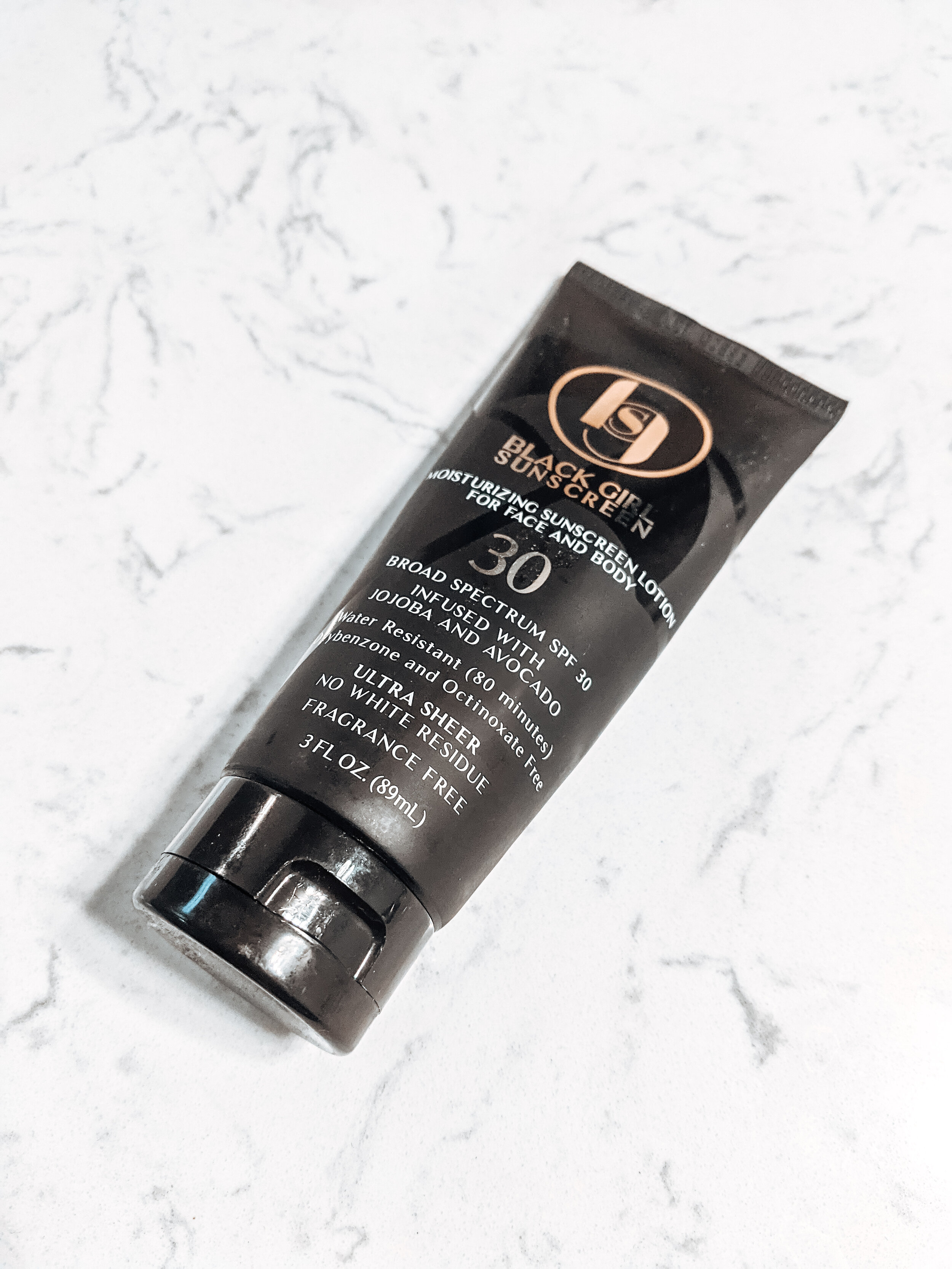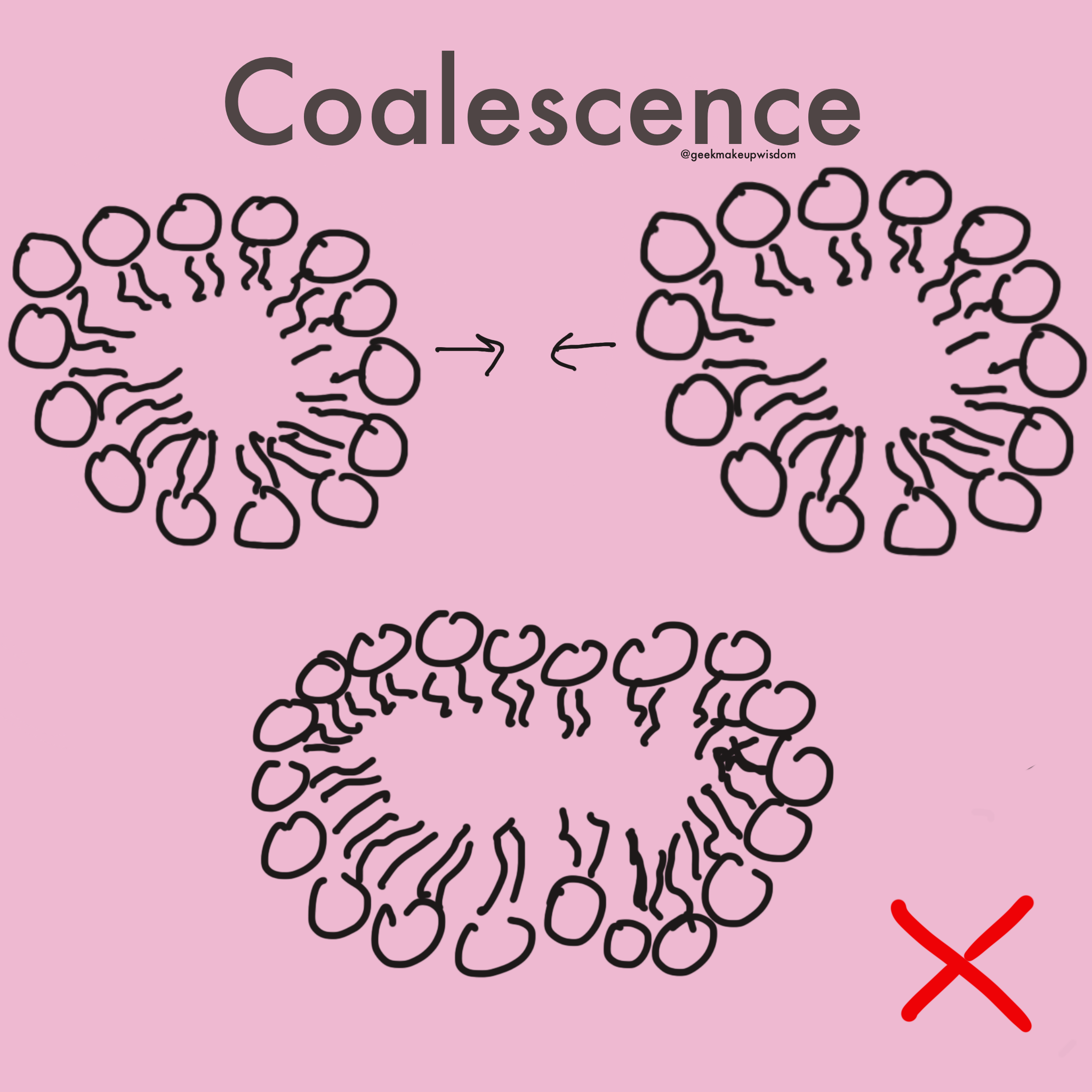THE REVIEW
For today’s scientific beauty review, I will be taking a look at my latest empty: Black Girl Sunscreen SPF 30. It’s a broad spectrum sunscreen I purchased directly from their site. I wanted to give this a try because the last sunscreen I purchased (Missha Essence Sun Milk SPF 50+/PA+++) was too drying for me.
I ended up really liking Black Girl Sunscreen’s formula because it made my skin routine a lot simpler since it felt moisturizing on its own; I didn’t need to wear moisturizer underneath. As someone with a lot of health issues, I sometimes don’t have the energy or ability to pamper myself with a 10-step skincare routine and need something that’s easy and quick to use. I have normal to dry skin, and Black Girl Sunscreen felt moisturizing enough to me to wear by itself during California’s mild winter. Just as promised on the tube, this formula is very sheer and has no white residue. Would I buy this again? Heck, yes!
THE SCIENCE
Let’s dive into the science of the sunscreen actives and the top three inactive ingredients of this formula. (I’ll also talk a bit about how I guessed at what the top three inactive ingredients are. Yay, deformulation!)
Sunscreen Actives
The sunscreen ingredients used in this product are avobenzone, homosalate, octisalate, and octocrylene.
Avobenzone (Butyl Methoxydibenzoylmethane)
This product uses the max concentration allowed in drug products in the US, which is 3% w/w. (1) It is a UVA absorber. (2) UVA light is absorbed by the aromatic rings of the molecule. (3) The raw material is a yellow solid which must be dissolved in the formula in order for it to be applied properly.
Homosalate (3,3,5-Trimethylcyclohexyl Salicylate)
This product contains 10% w/w homosalate, which is less than the allowable 15% w/w you can add to a sunscreen per the FDA. (1) But wait, if they’re using less than 15% w/w, does that mean you’re getting enough UV protection? Yes! You can still achieve broad spectrum protection by using a combination of sunscreen actives. (Also, maxing out the amount of sunscreen actives in a formula can have negative impacts on its aesthetics.) The salicylate portion is the part of the molecule that actually absorbs UVB, while the 3,3,4-trimethylcyclohexanol part is a fatty alcohol that imparts an emollient, non-oily feel. (4-5)
Octisalate (INCI: Octyl Salicylate)
Octisalate absorbs UVB. (6) It’s often paired up with avobenzone since it can solubilize it fairly well. (7) In this formula, it’s used at the FDA and EU max concentration (5% w/w). (1,8 )
Similar to homosalate, the salicylate portion of the molecule absorbs the UV rays. (5) The octisalate’s ethylhexanol portion is a fatty alcohol, which imparts its emollience and water resistance. (5)
Octocrylene (2-Ethylhexyl-2-Cyano-3,3-Diphenylacrylate)
Octocrylene can be used up to 10% w/w in sunscreens per the FDA, the EU, Japan and China; Canada allows usage up to 12% w/w. (1,9) This product uses 2.75% w/w.
The cyanoacrylate portion of the molecule absorbs UVA and UVB waves. (10-13) Like octisalate, it’s often paired up with avobenzone since it can solubilize it. It also can help to stabilize avobenzone. (14-15) This sunscreen is usually formulated with UVA and UVB filters to achieve broad spectrum protection. (12)
Top 3 Inactive Ingredients
You may be aware that for cosmetic products, ingredients must be listed in order of dominance in the formula. However because this is a drug product, inactive ingredients are listed in alphabetical order. (16) So how do you figure out the “top three” inactive ingredients? With some sleuthing!
1. Research the possible trade names and guess what materials are being used in the formula.
I usually hop straight to UL Prospector to start searching for any INCIs in the ingredient list I’m not readily familiar with. (I highly recommend this site if you can create a login. The access to supplier literature is invaluable.)
For example, if you search for “butylphthalimide,” you immediately see that it’s part of a trade name called “Pelemol BIP-PC.” What else is part of this mixture? Isopropylphtalimide, which is also in Black Girl Sunscreen’s ingredient list. This is the ingredient most likely in the formula. If you review the literature and some example formulas, you’d see that it’s a sunscreen solvent. (17)
Another example I want to point out is that if you search for acrylates/C10-30 alkyl acrylate crosspolymer, you’ll see that this material is cited as either a polymeric emulsifier or emulsion stabilizer with many other trade names...so which one is it?
I took a look at the formula and found two other emulsifiers: lecithin and sorbitan oleate. Lecithin is a low HLB emulsifier (18) that I don’t really consider a primary emulsifier. (19) Sorbitan oleate is a really common low HLB emulsifier (20); it’s also commonly known by Croda’s trade name “Span 80.” (21)
If you search for this acrylates/C10-30 alkyl acrylate crosspolymer, you’ll probably come across this piece of Lubrizol literature which talks about the use of Pemulens in sunscreen formulas. (22) (Hint, hint). Now if you look at Pemulen TR-1, TR-2, and EZ-4U, you’ll see that they have different capacities for how much oil phase they can emulsify. TR-1 can emulsify around 20% w/w and TR-2 and EZ-4U can emulsify up to 50% w/w. (23-24)
Now we have to think: what’s in our oil phase? We have the sunscreens and a bunch of emollients: the aforementioned Pelemol BIP-PC, carrot oil, sunflower oil, avocado oil, jojoba seed oil, and cocoa seed butter. If the sunscreens already make up 20.75% w/w of the oil phase, then it’s not likely that Pemulen TR-1 was used.
So am I saying that this is an o/w emulsion? I think so! There are water phase thickeners in this formula like carbomer and hydroxypropyl methylcellulose which make me think that water is the external phase. Thickening your external water phase helps to stabilize the emulsion.
Sorbitan oleate, the low HLB emulsifier, is probably in the formula to help balance out the HLB since there are a lot of oil phase ingredients in this formula.
2. Research the % w/w range
Again, this can be achieved by doing some literature searches for all of the materials. If you can’t make a ULP account, you can check these ingredients on sites like MakingCosmetics.com--they also share the % w/w range of ingredients on their site
3. Make an educated guess on the estimated % w/w based on the suggested ranges from Step 2.
I already kind of touched upon guessing relative % w/w’s in Step 1; the more you formulate (and deformulate), the more educated guesses you can make as to the % w/w.
4. Put ingredients in order
My guess for the top three inactive ingredients in this formula are water, Pelemol BIP-PC, and sorbitan oleate. Let’s talk about these three ingredients!
Water
Because this is an o/w emulsion, it makes sense that water would be the most abundant ingredient since it’s the external phase. Why? Remember that a typical emulsion has two phases: an internal phase (the droplets encased by the surfactant molecules) and the external phase. (If you don’t already know, o/w means “oil-in-water.”) If you have really large oil droplets, they’ll feel more attracted to each other just because they’re close to each other. When that happens, they coalesce into one phase...This is bad! You want the phases integrated with each other. You know from experience that water and oil don’t mix on their own--they need a surfactant. If you have really small oil droplets, then it’s easier to keep these droplets apart and homogeneously dispersed in the water.
If you ever look at an ingredient list and think, “Hey! Why is water the most abundant thing in this formula? Are they cheating me out and diluting the good stuff?” No--it’s most likely because you want the water there for stability of the formula!
Pelemol BIP-PC (Butylphthalimide and Isopropylphtalimide)
This material from Phoenix Chemical is described as a sunscreen solvent for avobenzone (which is one of the sunscreen actives in this formula). It also imparts a satiny feel to the formula. (17)
Sorbitan Oleate
I already talked about this ingredient a bit before, but it’s also worth noting that it’s a nonionic emulsifier that’s often paired with high HLB polysorbates (or “Tweens”, as Croda calls them). (25)
Conclusion
I hope you learned a lot from this post on the science of this sunscreen! You can buy it at Target or from their website.
P.S. Black Girl Sunscreen has a recycling program with their bottles! All the more reason to purchase from them. <3
References
Vielhaber, G.; Grether-Beck, S.; Koch, O.; Johncock, W.; and Krutmann, J. Sunscreens with an absorption maximum of > or =360 nm provide optimal protection against UVA1-induced expression of matrix metalloproteinase-1, interleukin-1, and interleukin-6 in human dermal fibroblasts. Photochem Photobiol Sci. 2006 Mar;5(3):275-82. https://doi.org/10.1039/b516702g
Paris, C.; Lhiaubet‐Vallet, V.; Jiménez, O.; Trullas, C. and Miranda, M.Á. A Blocked Diketo Form of Avobenzone: Photostability, Photosensitizing Properties and Triplet Quenching by a Triazine‐derived UVB‐filter. Photochemistry and Photobiology. 2009;85:178-184. https://doi.org/10.1111/j.1751-1097.2008.00414.x
MFCI, “Homoslate Technical Data Sheet,” Version 11, May 2018.
Galaxy Surfactants Ltd., “GalSORB Homoslate Technical Data Sheet,” Version 02, April 2016.KimiKa LLC, “iSun HMS Technical Data Sheet.”
KimiKa LLC, “iSun OS Technical Data Sheet,” Version 0.0, December 2015.
Symrise, “UV Protection Neo Heliopan®️ OS 131494.”
DSM, “Parsol®️ EHS Product Data Sheet,” PDS 50 1578 7 Version 01, July 2015.Galaxy Surfactants, “GalSORB Octyl Salicylate Technical Data Sheet,” Version 01, February 2017.
Cosphatech LLC, “iSun OCR Technical Data Sheet.”
KimiKa LLC, “iSun OCR Technical Data Sheet.”
Partners in Chemicals, “Omnistab UV 3039.”
Symrise, “UV Protection Neo Heliopan®️ 303 600154.”
Symrise, “Neo Heliopan®️ 303 PN 600154, Effective UVB Absorber, Sun Protection.”
MFCI, “Octocrylene Technical Data Sheet,” Version 13, December 2018.
Making Cosmetics Inc., “Octocrylene Fact Sheet,” December 2012.
Food and Drug Administration (FDA), (2008) Guidance for Industry - Labeling OTC Human Drug Products - Questions and Answers. Maryland: Food and Drug Administration (FDA).
Phoenix Chemical, Inc., “Pelemol®️ BIP,” February 2000 [Revised August 2004].
Making Cosmetics Inc., “Lecithin Fact Sheet,” December 2019.
Lucas Meyer Cosmetics, “EmulmetikTM BiophilicTM AmisolTM Soft HeliofeelTM: Phospholipid-Based Emulsifers.”
Making Cosmetics Inc., “Sorbitan Oleate Fact Sheet,” December 2014.
Croda Inc., “SPANTM Series,” DS-245R-2, December 2013.
Boo, M.F., He, C., De Maesschalck, E. and Ollagnier, M. Formulating High Performance Sun Care Products. Happi Magazine. 2012 Sep: 74-77.
Lubrizol Advanced Materials Inc., “Introducing PemulenTM Polymeric Emulsifiers,” TDS-114, January 2002.
Lubrizol Advanced Materials Inc., “PemulenTM EZ-4U Polymeric Emulsifer,” March 2017.
Croda Inc., “TWEENTM Series,” DS-227R-2, December 2013.





